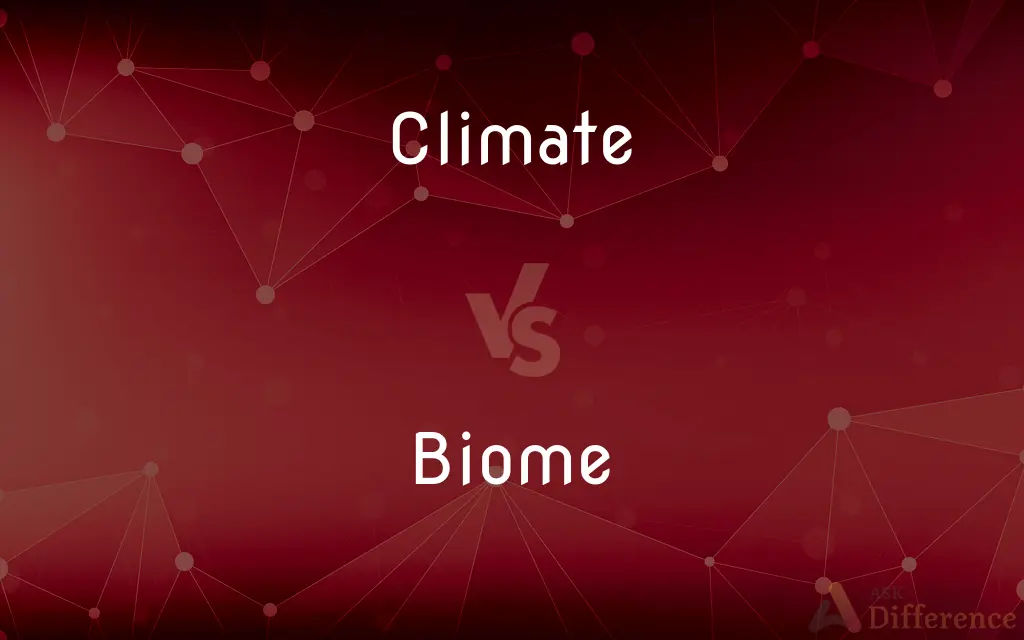Climate vs. Biome — What's the Difference?
By Tayyaba Rehman — Updated on September 30, 2023
Climate refers to long-term weather patterns in a region; a biome is a large ecological area on the earth’s surface with distinctive plant and animal groups adapted to the environment. Climate influences the characteristics of a biome.

Difference Between Climate and Biome
Table of Contents
ADVERTISEMENT
Key Differences
Climate and Biome are interconnected ecological concepts defining different aspects of the earth’s environment. Climate refers to the long-term patterns and averages of weather conditions, such as temperature, precipitation, humidity, and wind, in a particular region. It shapes the characteristics of a region and influences the types of life that can exist there. Biome, on the other hand, is a large ecological area on the earth’s surface with flora, fauna, and microorganisms that are adapted to the prevailing climate and other environmental conditions.
Climate is determined by a variety of factors, including latitude, altitude, and proximity to oceans and mountains. It is a key determinant of the energy balance of a region and has a direct impact on the types of plants and animals that can survive there. In contrast, a biome is determined by the interaction of living organisms with their environment, including the climate. It is characterized by distinctive plant and animal groups that have adapted to the specific environmental conditions, including the climate, of the region.
Climate plays a crucial role in defining the characteristics of a biome by influencing the availability of resources like sunlight, water, and temperature. It affects the suitability of a region for specific types of plants, animals, and other organisms. Biomes, defined by similar climatic conditions, can be found in different parts of the world and host different species adapted to those conditions. For example, desert biomes have species adapted to low precipitation levels, while tropical rainforest biomes host species adapted to high temperatures and rainfall.
The understanding of climate and biome is crucial for studying biodiversity, ecology, and environmental science. The study of climate helps in predicting weather patterns, understanding climate change, and managing its impacts. Studying biomes helps in understanding the adaptation and interaction of life in different environmental conditions, enabling the conservation of biodiversity and management of natural resources.
In summary, while climate is about the long-term weather patterns of a region, a biome represents the ecological area defined by distinctive plant and animal groups adapted to the environment, significantly influenced by the prevailing climate. The correlation between climate and biome is essential for understanding the diversity and distribution of life on Earth.
ADVERTISEMENT
Comparison Chart
Definition
Long-term weather patterns in a region.
Large ecological area with distinctive plant and animal groups.
Influences
Determines the environmental conditions of a region.
Defined by the interaction of organisms with their environment.
Characterization
Characterized by temperature, precipitation, humidity, and wind.
Characterized by flora, fauna, and microorganisms adapted to the environment.
Importance
Helps in predicting weather patterns and managing climate impacts.
Essential for studying biodiversity, ecology, and environmental conservation.
Related to
Related to meteorological conditions and atmospheric phenomena.
Related to ecological and biological aspects of life on Earth.
Compare with Definitions
Climate
The average weather conditions in a region over a long period.
The climate of the Sahara Desert is characterized by extreme heat and scant rainfall.
Biome
A large community of flora and fauna occupying a major habitat.
The rainforest biome is rich in biodiversity with numerous species of plants and animals.
Climate
A characterization of a region's atmospheric conditions.
The climate in tropical regions is typically warm and humid.
Biome
A major ecological community type.
The desert biome is characterized by low precipitation and extreme temperature variations.
Climate
Influences the environmental and living conditions in a region.
The polar climate in the Arctic creates a unique environment with specialized fauna.
Biome
A biome is a distinct biogeographical unit consisting of a biological community that has formed in response to a shared regional climate. Biomes may span more than one continent.
Climate
Climate is the long-term average of weather, typically averaged over a period of 30 years. More rigorously, it is the mean and variability of meteorological variables over a time spanning from months to millions of years.
Biome
A major regional or global biotic community, such as grassland or desert, characterized chiefly by its prevailing climate and vegetation.
Climate
The meteorological conditions, including temperature, precipitation, and wind, that characteristically prevail in a particular region.
Biome
Any major regional biological community such as that of forest or desert.
Climate
A region of the earth having particular meteorological conditions
Lives in a cold climate.
Biome
All the genomes of such a community.
Climate
A prevailing condition or set of attitudes in human affairs
A climate of unrest.
Biome
A specific type of complex ecological community characterized by specific environmental conditions and a distinctive group of plants and animals, maintained in a relatively stable equilibrium, such as a rain forest biome or prairie biome.
Climate
The long-term manifestations of weather and other atmospheric conditions in a given area or country, now usually represented by the statistical summary of its weather conditions during a period long enough to ensure that representative values are obtained (generally 30 years).
Biome
A particular region which is a biome{1}.
Climate
(figuratively) The context in general of a particular political, moral, etc., situation.
Industries that require a lot of fossil fuels are unlikely to be popular in the current political climate.
Biome
A major biotic community characterized by the dominant forms of plant life and the prevailing climate
Climate
(non-standard) climate change
Biome
An area of the earth’s surface with similar environmental conditions, inhabited by similar types of plants and animals.
The tundra biome has unique plant species adapted to its harsh, cold climate.
Climate
(obsolete) An area of the earth's surface between two parallels of latitude.
Biome
A collection of ecosystems with similar climatic conditions.
Different species can inhabit the same biome due to the similar climatic conditions.
Climate
(obsolete) A region of the Earth.
Biome
Represents large ecological areas with distinctive groups of plants, animals, and microorganisms.
The aquatic biome includes both freshwater and marine ecosystems, each hosting a variety of life forms.
Climate
To dwell.
Climate
One of thirty regions or zones, parallel to the equator, into which the surface of the earth from the equator to the pole was divided, according to the successive increase of the length of the midsummer day.
Climate
The condition of a place in relation to various phenomena of the atmosphere, as temperature, moisture, etc., especially as they affect animal or vegetable life.
Climate
To dwell.
Climate
The weather in some location averaged over some long period of time;
The dank climate of southern Wales
Plants from a cold clime travel best in winter
Climate
The prevailing psychological state;
The climate of opinion
The national mood had changed radically since the last election
Climate
A representation of long-term patterns of temperature, precipitation, and other atmospheric phenomena.
Scientists study climate to understand and predict changes in weather patterns.
Climate
The combination of temperature, humidity, precipitation, and wind in a particular area.
The Mediterranean climate is known for its hot, dry summers and mild, wet winters.
Common Curiosities
Does climate refer to long-term weather patterns?
Yes, climate refers to the long-term average weather conditions in a region.
Is a biome a large ecological area on the earth’s surface?
Yes, a biome is a large ecological area characterized by distinctive plant and animal groups adapted to the environment.
Can similar biomes be found in different parts of the world?
Yes, similar biomes can be found in different geographical locations with similar climatic conditions.
Does climate influence the characteristics of a biome?
Yes, climate significantly influences the characteristics and types of life found in a biome.
Is studying climate crucial for managing its impacts?
Absolutely, understanding climate is essential for predicting weather patterns and managing the impacts of climate change.
Share Your Discovery

Previous Comparison
Event vs. Exhibition
Next Comparison
Foon vs. SporkAuthor Spotlight
Written by
Tayyaba RehmanTayyaba Rehman is a distinguished writer, currently serving as a primary contributor to askdifference.com. As a researcher in semantics and etymology, Tayyaba's passion for the complexity of languages and their distinctions has found a perfect home on the platform. Tayyaba delves into the intricacies of language, distinguishing between commonly confused words and phrases, thereby providing clarity for readers worldwide.
















































